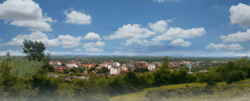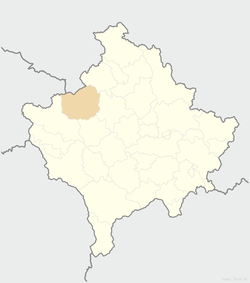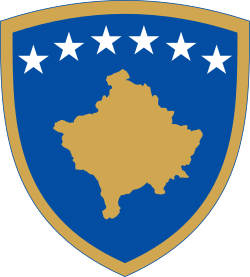Istok
Istok or Istog (Albanian: Istog, Istogu, Serbian: Исток, Istok) or Burim[1] is a town and municipality located in the Peć District of western Kosovo[lower-alpha 1]. According to the 2011 census, the town of Istok has 5,115 inhabitants, while the municipality has 39,289 inhabitants. Based on the population estimates from the Kosovo Agency of Statistics in 2016, the municipality has 39,982 inhabitants.
Istog | |
|---|---|
Town and municipality | |
| Albanian: Istog / Istogu Albanian: Burim / Burimi Serbian: Исток / Istok | |
 Town panorama of Istog | |
 Coat of arms | |
 Location of the municipality of Istok within Kosovo | |
| Coordinates: 42°47′N 20°29′E | |
| Country | Kosovo[lower-alpha 1] |
| District | District of Peć |
| Government | |
| • Mayor | Haki Rugova (LDK) |
| • Municipal | 454 km2 (175 sq mi) |
| Elevation | 480 m (1,570 ft) |
| Population (2011) | |
| • Urban | 5,115 |
| • Municipal | 39,289 |
| • Municipal density | 87/km2 (220/sq mi) |
| Time zone | UTC+1 (CET) |
| • Summer (DST) | UTC+2 (CEST) |
| Postal code | 31000 |
| Area code(s) | +383 |
| Car plates | 03 |
| Website | kk |
Name
The name of the town comes from the version of the Serbian word istok (variant istek), meaning "well, water source" referring to the springs of the Istočka river, a tributary to the White Drin river.[2] The name of the nearby village of Vrela, one of the largest settlements in the municipality, also means "springs", as does the newly proposed Albanian name of the town, Burimi.
History
The Ottoman defter (tax registry; census) of 1582 registered the Peć nahiyah as having 235 villages, of which Suho Grlo (Suvo Grlo) was located within modern Istok municipality. Suvo Grlo had three bigger mahala (neighbourhoods), whose inhabitants were Serbs. One of the neighbourhoods converted to Islam. There were several Orthodox priests in the village.[3]
Demographics
| Year | Pop. | ±% p.a. |
|---|---|---|
| 1948 | 25,292 | — |
| 1953 | 28,555 | +2.46% |
| 1961 | 33,779 | +2.12% |
| 1971 | 41,009 | +1.96% |
| 1981 | 50,104 | +2.02% |
| 1991 | 57,261 | +1.34% |
| 2011 | 39,289 | −1.87% |
| 2016 est. | 39,604 | +0.16% |
| Source: Division of Kosovo | ||
| Year | Pop. | ±% p.a. |
|---|---|---|
| 1948 | 2,074 | — |
| 1953 | 2,111 | +0.35% |
| 1961 | 2,657 | +2.92% |
| 1971 | 3,467 | +2.70% |
| 1981 | 4,478 | +2.59% |
| 1991 | 6,384 | +3.61% |
| 2011 | 5,115 | −1.10% |
| Source: Cities of Kosovo | ||
According to the last official census done in 2011, the municipality of Istok has 39,289 inhabitants.
Ethnic groups
The municipality of Istok has an ethnic Kosovo Albanian majority. Most of the Kosovo Serbs live in the village of Osojane.[4] Osojane is to the east of the city Istok; also part of the Serbs lives in northern part of the municipality.
The ethnic composition of the municipality:
| Ethnic Composition, Including IDPs | |||||||||||||
| Year/Population | Albanians | % | Serbs | % | Montenegrins | % | Bosniaks | % | Roma/Ashkali | % | Total | ||
|---|---|---|---|---|---|---|---|---|---|---|---|---|---|
| 1961 | 19,067 | 56.45 | 9,097 | 26.91 | 3,804 | 11.25 | 881 | 2.6 | 16 | 33,799 | |||
| 1971 | 27,371 | 66.74 | 8,944 | 21.81 | 2,420 | 5.90 | 1,876 | 4.57 | 243 | 0.59 | 41,009 | ||
| 1981 | 35,972 | 71.79 | 7,736 | 15.44 | 1,856 | 3.70 | 3,545 | 7.08 | 747 | 1.49 | 50,104 | ||
| 1991 | 43,910 | 76.68 | 5,968 | 10.42 | 1,302 | 2.27 | 4,070 | 7.11 | 1,346 | 2.35 | 57,261 | ||
| 1998 | 51,000 | 80.1 | 7,270 | 11.4 | |||||||||
| 2006 | 41,000 | 92 | 540 | 1.2 | 1,330 | 2.9 | 1,740 | 3.9 | 44,610 | ||||
| 2011 | 36,154 | 194 | 1,142 | 151 | 39,289 | ||||||||
| Ref: Yugoslav Population Censuses for data through 1991, and Organization for Security and Co-operation in Europe estimates for data in 1998 and 2006, 2011 estimate | |||||||||||||
Economy
After World War II, watermills on the river of Istok were nationalized and a new fish plant was built to operate as a socially owned enterprise. The company's name under Yugoslavia was "Ribnjak", meaning "piscatory" or "fishery" in Serbian. It was later privatized as Motel "Trofta", meaning "trout" in Albanian - the type of fish it has and is still producing, selling, and distributing. The company employs around 70 people. The company acts as a hotel and restaurant, often hosting traditional weddings. The hotel provides hotel rooms as well as small bungalows by the river.
Notable people
- Fadil Ferati, Mayor of Istok from 1999 to 2010
- Fatmire Bajramaj, footballer
- Mergim Brahimi, footballer
- Besim Kabashi, kickboxer
- Abdul Qader Arnaout, Islamic scholar
- Azdren Llullaku, footballer
- Ibrahim Rugova, former President of Kosovo
- Adnan Januzaj, footballer
- Radoš Ljušić, Serbian historian
- Mërgim Mavraj, footballer
- Donis Avdiaj, footballer
- Selman Kadria, local hero known for the assassination of a Serbian military commander
See also
Notes and references
Notes:
- Kosovo is the subject of a territorial dispute between the Republic of Kosovo and the Republic of Serbia. The Republic of Kosovo unilaterally declared independence on 17 February 2008, but Serbia continues to claim it as part of its own sovereign territory. The two governments began to normalise relations in 2013, as part of the 2013 Brussels Agreement. Kosovo is currently recognized as an independent state by 97 out of the 193 United Nations member states. In total, 112 UN member states recognized Kosovo at some point, of which 15 later withdrew their recognition.
References:
- Robert Elsie (2010). Historical Dictionary of Kosovo. Scarecrow Press. p. 297.
- Jovan Đ. Marković (1990): Enciklopedijski geografski leksikon Jugoslavije, page 87; Svjetlost-Sarajevo; ISBN 86-01-02651-6
- Vasić, Milan (1991), "Etnički odnosi u jugoslovensko-albanskom graničnom području prema popisnom defteru sandžaka Skadar iz 1582/83. godine", Stanovništvo slovenskog porijekla u Albaniji : zbornik radova sa međunarodnog naučnog skupa održanog u Cetinju 21, 22. i 23. juna 1990 (in Serbo-Croatian), OCLC 29549273
- Tanjug (12 July 2012). "Ivanović: Uspešan povratak Srba u Osojane". Blic.rs (in Serbian).
External links

- Municipality website (in Albanian)
